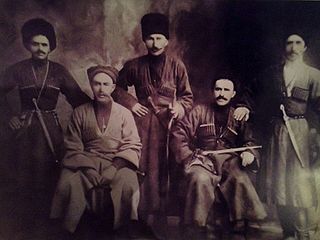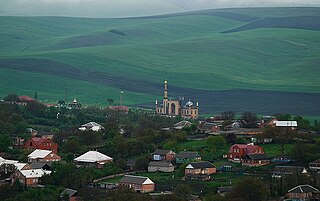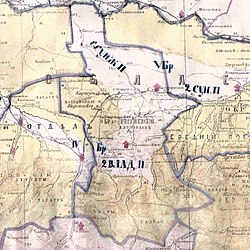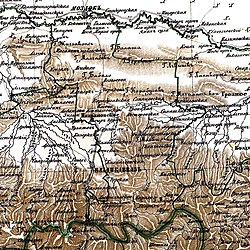Ingush, historically known as Durdzuks, Gligvi and Kists, are a Northeast Caucasian ethnic group mainly inhabiting the Republic of Ingushetia in central Caucasus, but also inhabitanting Prigorodny District and town of Vladikavkaz of modern day North-Ossetia. The Ingush are predominantly Sunni Muslims and speak the Ingush language.
Yalkharoy is a rural locality in Urus-Martanovsky District of the Republic of Chechnya, Russia.

The Orstkhoy, historically commonly known under their exonyms: Karabulaks, Balsu, Baloy, are a historical ethnoterritorial society among the Chechen and Ingush peoples. Their homeland is in the upper reaches of the Assa and Fortanga rivers in the historical region of Orstkhoy-Mokhk. In the tradition of the Chechen ethno-hierarchy, it is considered one of the nine historical Chechen tukkhums, in the Ingush tradition as one of the seven historical Ingush shahars.
Galashki is a rural locality in Sunzhensky District of the Republic of Ingushetia, Russia, located on the left bank of the Sunzha River near the border with the Republic of North Ossetia–Alania. Its population was about 9,000 people in 2009. Galashki forms the municipality of the rural settlement of Galashki as the only settlement in its composition.
Galanchozh, formerly Akhbosoy, is a non-residential rural locality in Urus-Martanovsky District of the Republic of Chechnya, Russia.

Fappi or Fappi mokhk, exonym: Kistetia, is a historical region in Ingushetia. Fappi is the territory of historical settlement of the Fyappiy society.

Galashians, were a historical Ingush ethnoterritorial society, which formed in the middle of the 18th century. The name comes from the village of Galashki, which is geographically located in the very center of the society. Galashians were located in the middle and lower reaches of the river Assa and the basin of the river Fortanga.
Ingush societies or shahars were ethnoterritorial associations of the Ingush based on the geographical association of several villages and intended for conditional administrative-territorial delimitation of the Ingush ethnic group. The formation and functioning of most of them dates back to the late Middle Ages. During this period, their boundaries, number and names changed.

Zaur or Zaurovo was an Ingush village that existed in the 18th–19th centuries on the right bank of the Terek River and in the Tarskoye Valley.

The Dzherakh, also spelled Jerakh, historically also known as Erokhan people, were a historical Ingush ethnoterritorial society, today a tribal organization/clan (teip), that was formed in the Dzheyrakhin gorge, as well as in the area of the lower reaches of the Armkhi River and the upper reaches of the Terek River.

Torshkhoy, also known in Ingush folklore as Them-Thoarshkhoy, is an Ingush clan (teip) which belongs to the Fyappin society. The ancestral auls of Torshkhoy are Tyarsh and Falkhan. A small number of representatives of the teip live in Aukh, where they are known under the name Vyappiy.

Tsorins, Tsori, also Ghalghaï, were a historical Ingush ethnoterritorial society that was located in mountainous Ingushetia in the region of river Guloykhi. The center of the society was Tsori from which it got its name. Tsorin society, like the Khamkhin society, was formed from the former "Galgaï society" as a result of the transfer (appearance) of rural government to the village Tsori.
Arshty is a rural locality in Sunzhensky District of the Republic of Ingushetia, Russia, located on left bank of the river Arshtynka near the border with the Republic of Chechnya. It forms the municipality of the rural settlement of Arshty as the only settlement in its composition.

Ekazhevo is a rural locality in Nazranovsky District of the Republic of Ingushetia, Russia. It forms the municipality of the rural settlement of Ekazhevo as the only settlement in its composition.

Plievo is a rural locality in Nazranovsky District of the Republic of Ingushetia, Russia. It forms the municipality of the rural settlement of Plievo as the only settlement in its composition.
Khay is a non-residential rural locality in Achkhoy-Martanovsky District of the Republic of Chechnya, Russia.

Meredzhi is a non-residential rural locality in Galanchozhsky District of the Republic of Chechnya, Russia.

Metskhal is an abandoned aul in the Dzheyrakhsky District of Ingushetia. It is part of the rural settlement of Lyazhgi.
Gorsky Uchastok was a territorial-administrative unit (uchastok) of the Ingushskiy Okrug of the Terek Oblast of the Russian Empire. The area of the Gorsky Uchastok made up Dzheyrakhsky and part of the Sunzhensky Districts of Ingushetia.
Karabulakskiy Uchastok was a territorial-administrative unit (uchastok) of the Ingushskiy Okrug of the Terek Oblast of the Russian Empire. The area of the Gorsky Uchastok made up Sunzhensky District of Ingushetia and Achkhoy-Martanovsky District of Chechnya.













